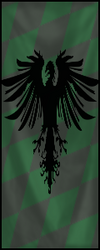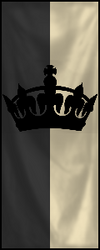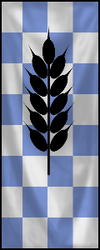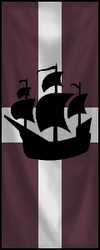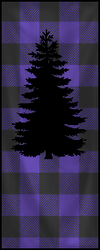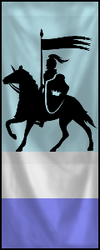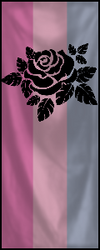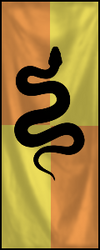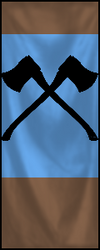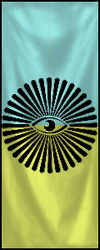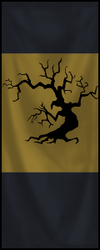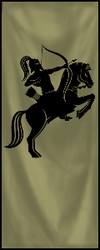More actions
No edit summary |
No edit summary |
||
| Line 8: | Line 8: | ||
*Humans (scientific) | *Humans (scientific) | ||
*Barbarians (Elven) | *Barbarians (Elven) | ||
|languages = | |languages = Languages references; see [[Ailor Naming]] | ||
|naming = Varied based on cultures; see [[Ailor | |naming = Varied based on cultures; see [[Ailor Naming]] | ||
|distinction = A culturally diverse people conquering both each other and the world. | |distinction = A culturally diverse people conquering both each other and the world. | ||
|maxage = | |maxage = 100 years | ||
|eye = Brown, green, grey, blue. | |eye = Brown, green, grey, blue. | ||
|hair = blond, ginger, brown, black, grey. | |hair = blond, ginger, brown, black, grey. | ||
|}} | |}} | ||
The Ailor are the most widespread and equally most disliked Race by other Races across the world. Barely an upstart population of tribes several thousand years ago, the Ailor have rapidly multiplied and spread across the world, founding dozens of Kingdoms and autocratic realms, creating Empires and destroying faraway nations that would soon be forgotten by time. The Ailor are an autocratic and imperialist Race who conquers far and wide, and then just as quickly collapses because of infighting, cultural differences, or religious confrontations. While other Races are generally united under one nation or faith, the Ailor are the most varied and diverse people, splintering so far that some would say two disparate cultures of Ailor are more dissimilar than the Ailor are to the Eronidas, an entirely different Race. The fate of Ailor on the world remains tumultuous, but as the dominant Race in the massive Regalian Empire, one of the foremost geopolitical powers on the world, they are the Race with the largest impact on the world, that much cannot be contested. | |||
== | ==Design== | ||
Ailor are considered the average middle ground between all other Races. There is nothing particularly out of the ordinary for them. Ailor can be race-coded to appear like any real world appearance (Caucasian, Asian, African, Hispanic, etc.) because skin tone and appearance isn't hard-coded to genetics in MassiveCraft Lore, children of light-skinned parents can be dark-skinned and have epicanthic eye folds, etc. All Ailor families are generally mixed in appearance, while every type of appearance can be found in any sub culture or Ailor nation across the world. There are short Ailor and there are tall Ailor. There are stocky and bulky Ailor and there are lanky and slim Ailor. There are ginger, blonde, black-haired and brunette Ailor, they can be tall or short, they can be gentle or harsh. Even their personalities are far and wide, with no common denominator. While Culture dictates some trend lines and guidelines, there is no common unifying personality traits among the Ailor, as cultural division means that each and every conceivable personality can be found among Ailor. This is why Ailor is a good starting Race, because there are no real rules on how to play one. | |||
Ailor are | |||
==Racial Abilities & Specials== | ==Racial Abilities & Specials== | ||
Racial Abilities are generally a set of unique powers and effects that all peoples of that race all innately have, while Specials are more passive, aesthetic focused capabilities. Specials are defined per-page, while Abilities can be searched on the [[Ability List]] page to determine their generic function. The Ailor do not have any Abilities as (with some exception) they are overwhelmingly Mundane and do not practice Magic, as such only having Specials. These Specials are intricately woven into Ailor culture and are considered "innate", which is why Ailor will mostly claim they don't have any Powers or Abilities (as they see their Specials as cultural quirks). Half Ailor have access to all of these Specials also. | Racial Abilities are generally a set of unique powers and effects that all peoples of that race all innately have, while Specials are more passive, aesthetic focused capabilities. Specials are defined per-page, while Abilities can be searched on the [[Ability List]] page to determine their generic function. The Ailor do not have any Abilities as (with some exception) they are overwhelmingly Mundane and do not practice Magic, as such only having Specials. These Specials are intricately woven into Ailor culture and are considered "innate", which is why Ailor will mostly claim they don't have any Powers or Abilities (as they see their Specials as cultural quirks). Half Ailor have access to all of these Specials also. All of these Specials are furthermore also optional. While some may for example dictate a birth condition, players are free to reject Specials altogether and not apply them to their Character. | ||
==Specials== | ==Specials== | ||
* '''Manifest Familiar:''' Each Ailor can be born with a Familiar that appears to them in their crib, and stays with them their entire life. Same rules as Pet Husbandry Pack apply, and if that Pack is bought, it gives access to two Familiars instead. Ailor Familiars live unnaturally long lives, and their presence is often explained in Ailor religions as a "watcher from the Gods". | |||
Ailor | * '''Dark Empathy:''' Each Ailor can disable their emotions or their conscience at will. They don't even really notice it when they do it, but this capacity has allowed the Ailor to commit great atrocities without feeling a thing. Additionally, they mind also allows them to self-impose a mind-block on certain things, by willfully erasing memories from themselves. | ||
* '''Practiced Mockery:''' Ailor have been subject to derision from other Races for centuries, and over the years learned how to uniquely understand ridicule and insult language in other Languages. Even if they do not speak another Language, if someone utters an insult at them in any Language they do not know, they will understand what the insult is and what it means. | |||
* '''Manifest Destiny:''' Ailor live short explosive and purpose driven lives. As such, they often excel more in the short term at tasks that other Races take slower and longer to master. While the Proficiency System normally allows a maximum of 7 Point investment per Category, Ailor may choose one Category in which to raise the limit to 8 instead. | |||
* '''Destiny Stressors:''' Ailor have a unique stress-response that other Races find quite peculiar. Regardless of what age or condition an Ailor is in, or what hair color they have, when an Ailor experiences a period or event of great stress and trouble, their hair or parts of their hair can turn snow white, with color only returning when their situation improves. | |||
* '''Job Opportunities:''' While isn't really a Special per-se, it is worth noting that while the Roleplay world exists in an Ailor-dominated society, it is always expected that Ailor have an easier time being hired in government and court position jobs than other Races do, purely because they are the preferred candidate within an Ailor dominated society. | |||
Ailor live | |||
* | |||
==Cultures== | |||
The Ailor Race is subdivided over many cultures, more than any other Race, and as such it is hard to really identify a unified World View that applies to even half of them. As such, the Cultures outlined below are the various Playable Cultures. To complicate matters further, each Ailor may have slightly different quirks and habits depending where they come from, information which can be sourced from the [[Geography]] Page. To keep things simple however, it is always safe to say your Character is a Regalian native, either born in Regalia or moved there shortly after, thus giving a very vanilla approach to Character Design. | |||
<!--#################################### CURIA CORDIS ##############################################--> | |||
{| class="wikitable" | |||
{| style="color: black; background-color: #4A8757; width: 90%;" align="center" | |||
! colspan="3" | | |||
Ailor Cultures | |||
|- style="background:#eee;" | |||
| rowspan="2" style="width: 7%; text-align:center;" | | |||
'''Wirtem''' | |||
[[File:Wirtem22.png|100px]] | |||
| | |||
The Wirtem people hail from the eastern regions of the Regalian Archipelago, the Greater Calemberg, Genevaud, Calderliga and Waldmark dark-forest regions that were once home to the smaller Wirtemcaller Kingdoms and Principalities that far predate the Empire. As the Regalian Empire expanded, it would eventually start a successful policy of politial marriages and peaceful unifications with these entities. They would quickly however be dragged into conflict with the Velheim in the north, creating decades of brutal warfare that would shape the mindset of the Wirtem people, eventually molding them into the Empire's primary military culture. | |||
|- style="background:white;" | |||
| | |||
* The Wirtem are an honor bound culture who absolutely hate using verbal insults. They insist on dignified interactions, and refrain from name-calling. | |||
* The Wirtem are a strongly Unionist Culture with a strong leaning for Purity, meaning without any Magic or Occult Aberrancy to the point of discrimination. | |||
* The Wirtem are an honor bound people, never attacking from behind, protecting the honor and good name of women, and remaining loyal to lord and master. | |||
* The Wirtem speak Wirtem, based on real-world German, while their names are also German inspired with "von" and "zu" being common prefixes in surnames. | |||
* The Wirtem are a strongly patriarchal culture where women don't get much of a say in the household, and men decide nearly everything in daily life. | |||
* The Wirtem are a strongly militaristic culture that glorifies the military, warfare, the army, the navy, and praising careers in the State military. | |||
* The Wirtem are emotionally restrained and conservative by nature, seeking precedence from history, and finding great discomfort from change in life. | |||
* The Wirtem love the colors green and gray, symbolism of the military and Unionism, horse-riding, parades, horn-instruments and glorious temples. | |||
<!--#########################################################################################################--> | |||
|- style="background:#eee;" | |||
| rowspan="2" style="width: 7%; text-align:center;" | | |||
'''Regal''' | |||
[[File:Regalaa.png|100px]] | |||
| | |||
The Regal culture is an entirely artificial culture designed by the intelligentsia and educated folk of the Regalian Empire to counteract the never-ending cultural divisions and conflicts within the Empire, in the hopes of erasing these issues for a brighter future. The Regal culture took aspects of Leutz-Vixe and Dressolini, two hybrid cultures that sought to improve upon Ithanian and Daen alike, eventually adding Wirtem and Anglian elements until a stable mixture was reached. The culture now controls all the major bureaucratic, legal, and administrative centers of the Regalian Empire, quickly becoming the "culture of rulers". | |||
|- style="background:white;" | |||
| | |||
* The Regal as an artificial culture, are all about cultural assimilation and absorbing good aspects of other cultures into homogenous patriotism. | |||
* The Regal are a strongly Unionist Culture with a fervent support for the Imperial family and the centralized bureaucracy of the Regalian Empire. | |||
* The Regal are all about self exploration, discovery, and ambition, how to become the best version of one's self through self awareness and meditation. | |||
* The Regal mostly speak Common, preferring a language that is shared by most Ailor Cultures and other Races for ease of communication and social living. | |||
* The Regal have no gender preference, but strongly favor gender-roles in society, with both matriarchs and patriarchs enforcing expectation of gender roles. | |||
* The Regal culture is one that strongly emphasizes nationalist pride in the Regalian Empire, high-class life style, dignity and wealth, and independence. | |||
* The Regal are the most centrist of all cultures, politically, trying to build a mediating middle ground between all other Cultures for the good of Empire. | |||
* The Regal love the colors white, beige and black, symbolism of royalty and nobility, games of wit and skill, education, string-instruments and politics. | |||
<!--#########################################################################################################--> | |||
|- style="background:#eee;" | |||
| rowspan="2" style="width: 7%; text-align:center;" | | |||
'''Anglian''' | |||
[[File:Anglianflag.png|100px]] | |||
| | |||
The Anglian culture forms the bedrock of the Regalian Empire and they are proud of it. For hundreds, perhaps thousands of years, the Anglians have been a rooted and traditional culture in Anglia until the Five Family Rebellion began there, an event that would eventually form the Regalian Empire. Since then, Anglia has progressively turned into the Empire's bread basket, with the largely illiterate but fervently loyal Anglians being the first to sign up to armies, and the first to assist in whatever way they could to expand the Regalian Empire with pitchfork and sickle in hand. | |||
|- style="background:white;" | |||
| | |||
* The Anglian culture is one of ancient history and the roots of Empire, pride in the founding, but keeping old folklore alive through oral telling. | |||
* The Anglian people are strongly divided, with many following Unionism, but many also holding true to Dragon Worship, particularly the Dragon Regulus. | |||
* The Anglian culture is all about loyalty, loyalty to each other, brotherhood to one's fellow workers and soldiers, and loyalty to one's feudal lord. | |||
* The Anglian speak Anglish which is based on real-world Dutch, having many local and regional dialects and accents to make it difficult to understand. | |||
* The Anglian don't have any gender norms outside of the strong expectation of couples to produce offspring, with dynastic-continuation being very important. | |||
* The Anglian culture strongly emphasizes a rural approach to life, a love for agriculture and cattle rearing, and being uneasy in surroundings of brick and stone. | |||
* The Anglian people are conservative, and to a degree even bigoted towards non-Ailor Races, preferring their homogenous homeland of Anglia which never changes. | |||
* The Anglian love the colors blue and purple, symbolism of Dragons and Witches, Longbow archery, farming, forests and lush grassy fields and flowers. | |||
<!--#########################################################################################################--> | |||
|- style="background:#eee;" | |||
| rowspan="2" style="width: 7%; text-align:center;" | | |||
'''Cearden''' | |||
[[File:Cearden.png|100px]] | |||
| | |||
The Cearden people are not native to the Regalian Empire, rather a culture that was once at the root of all Ailor in the old continent of Ceardia. Since then, the culture has developed, eventually caught in the orbit of the Regalian Empire, and "civilized" by it, as many would claim. Since then, the Cearden have found that their generally likeable, generous and gregarious demeanor made them the perfect travelers and traders, spreading the Empire's coinage far and wide and thus their trade ports, and thus their language, to the point that Common is the most spoken language in the world aside from Allorn. | |||
|- style="background:white;" | |||
| | |||
* The Cearden culture is as heartland as it gets, a metropolitan amalgam of influences from all manner across the Regalian Empire, built on trade. | |||
* The Cearden culture is predominantly Unionist, though small pockets of Old Gods followers still remain, holding onto old beliefs in isolated areas. | |||
* The Cearden culture is all about trade, exploration, and the high seas, with most sailors and seamen being of Cearden descent or training. | |||
* The Cearden people speak Common based on real-world English, which is easy to learn for all Races, and so widespread that it has become a world language. | |||
* The Cearden people are the ideal gender neutral when it comes to gender norms and expectations, having truly no preference or expectation difference. | |||
* The Cearden culture emphasizes curiosity, interest, poetry, reading, and learning as much as possible from the things one has never experienced. | |||
* The Cearden people are largely progressive, but only mildly so, preferring progress to be slow, steady, and predictable to their financial interests. | |||
* The Cearden love the colors burgundy and red, symbolisms of the seas and wealth, theatre and stage play, literature, guilds and finance and commerce. | |||
<!--#########################################################################################################--> | |||
|- style="background:#eee;" | |||
| rowspan="2" style="width: 7%; text-align:center;" | | |||
'''Gallovian''' | |||
[[File:Galloviaffn.png|100px]] | |||
| | |||
The Gallovian culture is a daughter culture of the Cearen when these people mixed with the Breizh, Velheim and Anglians, and colonized the rugged Gallovian highlands in the Regalian Archipelago, as well as the surrounding scarcely populated and unfertile islands. Due to the harsh conditions of living on these islands, the Gallovian people are known as hardy mountain folk with a streak for animalistic spiritualism and stubborn-ness that cannot easily be rivaled by the other cultures. A Gallovian is hard to befriend, due to the natural district, but one of the warmest and hospitable friends anyone could have. | |||
|- style="background:white;" | |||
| | |||
* The Gallovian are best known as mountain folk living in the more rocky regions of the world, spread across islands and the Regalian Archipelago. | |||
* The Gallovian culture is part Unionist, part Old Gods, part Pagan Animal faiths, and somehow they all keep relatively peaceful among themselves. | |||
* The Gallovian culture is all about survival, independent living, mountaineering and the traveling the cold rainy glens of their homeland. | |||
* The Gallovian people speak Gallwech based on real-world Scots Gaelic, though many of them adopt Common names for easier pronunciation sake. | |||
* The Gallovian culture is a patriarchal culture where strength makes right, which usually involves men dominating the household and family life. | |||
* The Gallovian culture emphasizes brotherhood, loyalty to one's family above all, respect for animals and particularly wolves, and open air sports. | |||
* The Gallovian people are jingoistic, favoring a policy of no-recognition and warfare with foreign nations to aggressively expand the Regalian Empire. | |||
* The Gallovian people love plaid patterns in dark colors, symbolisms of wolves and mountains, wood carving, Gallovian Whiskey, wood cabins and feasts. | |||
<!--#########################################################################################################--> | |||
|- style="background:#eee;" | |||
| rowspan="2" style="width: 7%; text-align:center;" | | |||
'''Breizh''' | |||
[[File:Breizhff.png|100px]] | |||
| | |||
The Breizh people can best be summed up as the most iron-clad warriors of a rugged land in the Archipelago. Hailing from the relatively small region of Kintyr, the Breizh people are one of constant internal warfare and struggle, breeding the toughest soldiers that are most accustomed to full plate armor and chainmail that one could wish for. A culture deeply steeped in folklore, legend, and the fantastical aftermath of fairy beliefs, the Breizh were one of the first to support the rise of the Regalian Empire, and quickly secured a highly autonomous and advantageous position within it. | |||
|- style="background:white;" | |||
| | |||
* The Breizh people are best known for their love for Knights and their skills in the forges of the Ailor realms, as well as the best castle architects. | |||
* The Breizh culture is entirely Unionist. While they once followed the Faith of Elen of the Lakes, this goddess was incorporated into Unionism. | |||
* The Breizh culture is all about family history, they obsess about telling the legends of their forefathers on intricately woven wall tapestries. | |||
* The Breizh people speak real-world Cornish, with all manner of Arthurian flair, and elements of Normand and Welsh place names and terms. | |||
* The Breizh culture is gender-neutral, but generally one that favors hawkish and militarily capable matriarchs or patriarchs with a long legacy. | |||
* The Breizh culture emphasizes respect for the motherland and the land itself, diligence in the craft of armor and weapons, and a strong sword arm. | |||
* The Breizh culture is neither overtly conservative nor progressive, with conservative ideas, yet pro-Occult progressive concepts and leanings. | |||
* The Breizh culture adores the colors silver, white, and dark blue, anything metal, anything warlike, and large and bombastic stone palaces and castles. | |||
<!--#########################################################################################################--> | |||
|- style="background:#eee;" | |||
| rowspan="2" style="width: 7%; text-align:center;" | | |||
'''Ithanian''' | |||
[[File:Ithanianff.png|100px]] | |||
| | |||
The Ithanian people are known around the world as the most opulent party-goers, the wealthiest bankers and high-culture craftsmen, and the trendsetters and influencers of cultural expression and fashion. They draw both awe and amazement at how much they can spend on looking beautiful and the center of attention, and while they developed in their native Ithania away from the Regalian Empire, perfectly integrated bringing their wealth with them to cause a massive economic boom in the Empire. Since then, Ithanian has effectively become the style of court, with every Ailor royal house imitating their dress and code. | |||
|- style="background:white;" | |||
| | |||
* The Ithanians love festivities and the eternal competition of the fairest of the land, a thin veneer to hide their extremely cut-throat court politics. | |||
* The Ithanians are universally Unionist, a religion that quickly found roots among them following the collapse of the Allorn Empire and their newfound freedom. | |||
* The Ithanians focus on the so-called Jeu-de-courts, a game in which everyone must be a player to compete for favor, upstage others, or die trying. | |||
* The Ithanians speak d'Ithanie, based on real-world French, with long and complex naming customs called Moon-Names that can often have up to 10 names in them. | |||
* The Ithanian culture is functionally gender-equal, but demands excluding men only from leading positions, with women being the high focus of command. | |||
* The Ithanians emphasize the chase for beauty, fine-ness, class and always presenting one's best self. Many Ithanian honeyed words hide behind fans and gestures. | |||
* The Ithanians are strictly progressive, always battling for expanded rights for other Races, religions, and above all individual liberties and press freedom. | |||
* The Ithanians adore the colors white, pink and baby-blue, long dresses and large hats, flowers, marble statues, watching male sports, and the service industry. | |||
<!--#########################################################################################################--> | |||
|- style="background:#eee;" | |||
| rowspan="2" style="width: 7%; text-align:center;" | | |||
'''Daendroque''' | |||
[[File:Daenloss.png|100px]] | |||
| | |||
The Daendroque people are fiercely independent, will never accept anyone telling them what to do, and seek ways to carve out their own legacy and wealth at the expense of others anywhere they can. Having developed from ex-Allorn slave populations, the Daendroque had to unite and rebel to survive, a tradition that has been upheld to the modern day with them uniting in families and creating pseudo-gang warfare to protect their own housing communities and families from encroachment. Their plantations yet fuel the Regalian economy, while their hardy resistance to central rule gives the government many headaches. | |||
|- style="background:white;" | |||
| | |||
* The Daendroque people are freedom-loving business-minded entrepreneurs, who invariably end up using underhanded and roguish techniques to get success. | |||
* The Daendroque are predominantly Unionist, even devoutly so, to the point of often causing conflict with their barely legal activities in business. | |||
* The Daendroque people are all about the family, which is less a blood-relation, but more-so all families and groups together in one walled community. | |||
* The Daendroque people speak Droque based on real-world Español, with a variety of dialects across the many governorates and ex-colonies in the west. | |||
* The Daendroque people have no overt gender preference, with the value of a person being defined by how useful they are to their community. | |||
* The Daendroque people emphasize bravery, standing up for one's self and others, independence, pride and service to the community above all. | |||
* The Daendroque people are inherently progressive, but have some autonomous leanings, preferring a decentralized weak state with less laws. | |||
* The Daendroque people love the colors orange and yellow, fruits, warm environments, sleight of hand games and gambling, and the vibrant night life. | |||
<!--#########################################################################################################--> | |||
|- style="background:#eee;" | |||
| rowspan="2" style="width: 7%; text-align:center;" | | |||
'''Velheim''' | |||
[[File:Velheimr.png|100px]] | |||
| | |||
Hailing from the mysterious and lost Vaarda, the Velheim are a sea-faring culture which once had colonies far and wide in the known world, but was eventually pushed back by the march of civilization to only the coldest regions in the north. Hardly uncivilized, the Velheim held a great respect for nature and a close-ness to it that not many other Races or cultures can compare with, but one that inevitably left them misunderstood as barbarians. The Velheim were eventually forced into the Regalian fold at the conclusion of the Skagger wars, though some independent states still exist in the deep north. | |||
|- style="background:white;" | |||
| | |||
* The Velheim are a proud and martial people steeped in the ways of old, a lifestyle from old Ceardia that even the Cearden have long since abandoned. | |||
* The Velheim almost universally follow the Old Gods, a religion they founded, and eventually spread to the far corners of the world with their Gateways and ships. | |||
* The Velheim people strongly believe in honor or Soldi, a rigid concept that demands they live their life in the name of honor, fairness, pride and bravery. | |||
* The Velheim speak Skodje based on real-world Norwegian, with many regional dialects and accents as numerous as the amount of villages and towns one can find. | |||
* The Velheim culture gender-equal, though there is an un-written male-dominance preference, as men have historically been more capable at seizing power. | |||
* The Velheim culture emphasizes faith and loyalty to the Old Gods, resistance to change, adherence to the traditions and customs of old, and fearlessness. | |||
* The Velheim people are staunchly traditionalist, with roots in jingoist even as they are first on the frontlines in war, even for an Empire they do not love. | |||
* The Velheim people love the colors white, brown, and blue, fur anything, leather anything, wood carvings, folklore, religious ritualism and care for the dead. | |||
<!--#########################################################################################################--> | |||
|- style="background:#eee;" | |||
| rowspan="2" style="width: 7%; text-align:center;" | | |||
'''Krainivaya''' | |||
[[File:Krainivayasss.png|100px]] | |||
| | |||
The Krainivaya people are perhaps the most exotic coming from far-away Essalonia, having fled magical prosecution at the hands of the Oltaran Republic. By the grace of the Regalian Emperors their refugees were allowed into the Regalian Empire to settle ex-Velheim lands in the north, building a resentment from those people. While inside the Empire. the Krainivaya have developed into the most courageous and stalwart defenders of the Emperor and the Imperial family, first to lay down their lives to solve even the slightest of inconvenience to their holy messiah who they have fully embraced. | |||
|- style="background:white;" | |||
| | |||
* The Krainivaya can best be understood as people of little means who yet survive in rough conditions, but have found deliverance and meaning in pious faith. | |||
* The Krainivaya are strictly Unionist, to the point of even showing disdain for the concept of religious freedom, and wishing to impose the love of the Emperor globally. | |||
* The Krainivaya are an inherently Purist and anti-Magic people who have the favor of the Emperor in return as his most fervent followers, always looking for traitors. | |||
* The Krainivaya speak Kriv, based on real-world Ukrainian, with strictly Ukrainian naming principles to distance from the (Russian) old Oltaran Republic. | |||
* The Krainivaya are strongly patriarchal, but a few break-through women have seized their moment to become matriarchs in their own right, thawing old traditions. | |||
* The Krainivaya culture emphasizes honesty and blunt truthfulness, being excellent penny-pinchers, and wrestling with cultural alcoholism hiding their harsh lives. | |||
* The Krainivaya aren't so much conservative as much as they just hate change, and would prefer to let any change directly come from the Emperor alone and no one else. | |||
* The Krainivaya adore the colors black and silver, jewelry, furs, faith, Unionist symbolism, snow, Krai Vodka, folk myths, and nobles who are accountable to their serfs. | |||
<!--#########################################################################################################--> | |||
|- style="background:#eee;" | |||
| rowspan="2" style="width: 7%; text-align:center;" | | |||
'''Întuneric''' | |||
[[File:Romanians.png|100px]] | |||
| | |||
The Întuneric are the wardens of Baldmark, the rugged lands which lay between the Wirtem and the sea. Gripped by struggle against Arcane disasters, raiders, and the afflicted, they navigate a difficult world by keeping balance in their beliefs. While some of the most zealous Unionists, the Întuneric also hold onto pagan traditions long-lost by their neighbors- and while harsh Purists who hate all Magic on paper, a deep infatuation with the glamour and eternal life of Vampires lies beneath their surface. Border lords of a thousand castles and magnificent smiths, the Întuneric upkeep their lineages with pride. | |||
|- style="background:white;" | |||
| | |||
* The Întuneric fight fire with fire: they contradict their beliefs to enforce them, bringing the tough lessons of their rough homeland to the city of Regalia. | |||
* The Întuneric are extremely Unionist beyond a doubt, but often maintain personal beliefs in witchcraft and ritual that fall outside of Unionist dogma. | |||
* The Întuneric are enamored with Afflictions: Archon left by the Dragons, and Vampires and Cahal taken on in the modern day - both curing, and becoming them, is their concern. | |||
* The Întuneric speak Înnora, a mixture of real-world Romanian and the Serbo-Croatian language spectrum which Regalians classify as one tongue for census purposes. | |||
* The Întuneric do not have gender roles. Their society is theoretically patriarchal, but the centuries-long struggle with the Szabadok broke barriers down. | |||
* The Întuneric culture emphasizes delving into the Occult for power, always exploring one's own boundaries, and protecting oneself against a harsh world that's out to get them. | |||
* The Întuneric often lean conservative, backing up the Empire 'as it is and was' for fear that its expanding horizons will eventually see them forgotten. | |||
* The Întuneric love the colors black, gold, and red, as well as Dragon symbolism, military orders, cloaks, folklore, superstition, and the Afflicted. | |||
<!--#########################################################################################################--> | |||
|- style="background:#eee;" | |||
| rowspan="2" style="width: 7%; text-align:center;" | | |||
'''Szabadok''' | |||
[[File:Cumanflag.png|100px]] | |||
| | |||
The Szabadok are the great horse lords of the open steppe, the finest cavalry in the Regalian Archipelago and perhaps the world. With an origin earlier than the oldest recorded history, they dwelt in their land before any state formed. By way of arms, they have raided every organized state to take a presence in their vicinity, including the Regalian Empire itself. Though their peaceful integration has been achieved after many years, there is a certain wildness in their hearts that even the city of Regalia cannot run out. | |||
|- style="background:white;" | |||
| | |||
* The Szabadok are independent-minded, warlike nomads with a strong belief in personal autonomy and taking what they want. | |||
* The Szabadok are strong Evintarian Unionists, although with an addition of folk ritual thrown into the mix. | |||
* The Szabadok are all about raiding, feats of hunting and bravery in the wilderness, martial strength, and defending their unique culture. | |||
* The Szabadok speak Réginyelv, a language based off of Hungarian, but recorded in the Farsi script. | |||
* The Szabadok have atypical gender beliefs: that men are the laborers, women are the warriors, and that those who lie in between must lead. | |||
* The Szabadok culture emphasizes might makes right, having the strength to overcome obstacles, hospitality to all, and showing loyalty to one's clan. | |||
* The Szabadok spent centuries tormenting Baldmark and other regions, but now that they are part of Regalia, they support any politician who will leave them alone. | |||
* The Szabadok love horses, the colors brown, green and blue, veils, tassels, sashes, expensive jewelry, falconry, sabres, and the call of the hunt. | |||
<!--#########################################################################################################--> | |||
|- style="background:#eee;" | |||
| rowspan="2" style="width: 7%; text-align:center;" | | |||
'''Aetosian''' | |||
[[File:Hellaspeople.png|100px]] | |||
| | |||
The Aetosian are the primary art producers and appreciators in the Regalian Empire, having thrived on the island of Etosil where the Evintarian heretics were expelled to after the first schism, the Aetosians turned a rugged land bereft of natural beauty into a paradise for the arts, particularly sculpting and architecture. Since, the Aetosians have returned in numbers in Hellatia in the Regalian Archipelago, plying their trade in the capital also, and enjoying the religious freedom given to them, to express their Evintarian Unionist beliefs in public. | |||
|- style="background:white;" | |||
| | |||
* The Aetosian are communal and artistic faithful who experience the natural beauty of the world and spirituality through art and devoutness in belief. | |||
* The Aetosian are devout Evintarian Unionists, and the original people from which this belief came, with most of their holy sites on Etosil. | |||
* The Aetosians are all about living a pious and beautiful life, having beautiful clothes, behaving without uglyness in personality and style. | |||
* The Aetosian speak Hellas, a language based on real-world Greek. Despite their open views on gender identity, their language is strictly binary. | |||
* The Aetosians are some of the most forward thinking when it concerns gender identity and bodily modifications, as well as even Race-changing. | |||
* The Aetosian culture strongly encourages creative exploration, though not only in the arts, Aetosians are also excellent military engineers and inventors. | |||
* The Aetosians are known across the Regalian Empire for having the most beautiful and devoted cloisters where monks live, dedicating their art and life to faith. | |||
* The Aetosians love the colors white and purple, loose linen and silk robed clothing, depictions of religion, piety, marble statues, scenery paintings and mountains. | |||
<!--#########################################################################################################--> | |||
|} | |||
|} | |||
==Trivia== | ==Trivia== | ||
*It is generally believed that the metaphysical concept of the “Crown of the World”, a term used to define the most powerful entity in the world, is currently carried by the Ailor, since the Altalar lost it (both the metaphysical concept and the actual crown which was taken by the Ailor). | *It is generally believed that the metaphysical concept of the “Crown of the World”, a term used to define the most powerful entity in the world, is currently carried by the Ailor, since the Altalar lost it (both the metaphysical concept and the actual crown which was taken by the Ailor). | ||
Revision as of 07:02, 1 September 2022
| Ailor | |
|---|---|
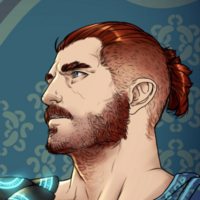 | |
| Race | |
| Pronunciation | eye-lor |
| Classification | Human |
| Subraces | None |
| Common Nicknames |
|
| Languages | Languages references; see Ailor Naming |
| Naming Customs | Varied based on cultures; see Ailor Naming |
| Racial Traits | |
| Distinctions | A culturally diverse people conquering both each other and the world. |
| Maximum Age | 100 years |
| Eye Colors | Brown, green, grey, blue. |
| Hair Colors | blond, ginger, brown, black, grey. |
The Ailor are the most widespread and equally most disliked Race by other Races across the world. Barely an upstart population of tribes several thousand years ago, the Ailor have rapidly multiplied and spread across the world, founding dozens of Kingdoms and autocratic realms, creating Empires and destroying faraway nations that would soon be forgotten by time. The Ailor are an autocratic and imperialist Race who conquers far and wide, and then just as quickly collapses because of infighting, cultural differences, or religious confrontations. While other Races are generally united under one nation or faith, the Ailor are the most varied and diverse people, splintering so far that some would say two disparate cultures of Ailor are more dissimilar than the Ailor are to the Eronidas, an entirely different Race. The fate of Ailor on the world remains tumultuous, but as the dominant Race in the massive Regalian Empire, one of the foremost geopolitical powers on the world, they are the Race with the largest impact on the world, that much cannot be contested.
Design
Ailor are considered the average middle ground between all other Races. There is nothing particularly out of the ordinary for them. Ailor can be race-coded to appear like any real world appearance (Caucasian, Asian, African, Hispanic, etc.) because skin tone and appearance isn't hard-coded to genetics in MassiveCraft Lore, children of light-skinned parents can be dark-skinned and have epicanthic eye folds, etc. All Ailor families are generally mixed in appearance, while every type of appearance can be found in any sub culture or Ailor nation across the world. There are short Ailor and there are tall Ailor. There are stocky and bulky Ailor and there are lanky and slim Ailor. There are ginger, blonde, black-haired and brunette Ailor, they can be tall or short, they can be gentle or harsh. Even their personalities are far and wide, with no common denominator. While Culture dictates some trend lines and guidelines, there is no common unifying personality traits among the Ailor, as cultural division means that each and every conceivable personality can be found among Ailor. This is why Ailor is a good starting Race, because there are no real rules on how to play one.
Racial Abilities & Specials
Racial Abilities are generally a set of unique powers and effects that all peoples of that race all innately have, while Specials are more passive, aesthetic focused capabilities. Specials are defined per-page, while Abilities can be searched on the Ability List page to determine their generic function. The Ailor do not have any Abilities as (with some exception) they are overwhelmingly Mundane and do not practice Magic, as such only having Specials. These Specials are intricately woven into Ailor culture and are considered "innate", which is why Ailor will mostly claim they don't have any Powers or Abilities (as they see their Specials as cultural quirks). Half Ailor have access to all of these Specials also. All of these Specials are furthermore also optional. While some may for example dictate a birth condition, players are free to reject Specials altogether and not apply them to their Character.
Specials
- Manifest Familiar: Each Ailor can be born with a Familiar that appears to them in their crib, and stays with them their entire life. Same rules as Pet Husbandry Pack apply, and if that Pack is bought, it gives access to two Familiars instead. Ailor Familiars live unnaturally long lives, and their presence is often explained in Ailor religions as a "watcher from the Gods".
- Dark Empathy: Each Ailor can disable their emotions or their conscience at will. They don't even really notice it when they do it, but this capacity has allowed the Ailor to commit great atrocities without feeling a thing. Additionally, they mind also allows them to self-impose a mind-block on certain things, by willfully erasing memories from themselves.
- Practiced Mockery: Ailor have been subject to derision from other Races for centuries, and over the years learned how to uniquely understand ridicule and insult language in other Languages. Even if they do not speak another Language, if someone utters an insult at them in any Language they do not know, they will understand what the insult is and what it means.
- Manifest Destiny: Ailor live short explosive and purpose driven lives. As such, they often excel more in the short term at tasks that other Races take slower and longer to master. While the Proficiency System normally allows a maximum of 7 Point investment per Category, Ailor may choose one Category in which to raise the limit to 8 instead.
- Destiny Stressors: Ailor have a unique stress-response that other Races find quite peculiar. Regardless of what age or condition an Ailor is in, or what hair color they have, when an Ailor experiences a period or event of great stress and trouble, their hair or parts of their hair can turn snow white, with color only returning when their situation improves.
- Job Opportunities: While isn't really a Special per-se, it is worth noting that while the Roleplay world exists in an Ailor-dominated society, it is always expected that Ailor have an easier time being hired in government and court position jobs than other Races do, purely because they are the preferred candidate within an Ailor dominated society.
Cultures
The Ailor Race is subdivided over many cultures, more than any other Race, and as such it is hard to really identify a unified World View that applies to even half of them. As such, the Cultures outlined below are the various Playable Cultures. To complicate matters further, each Ailor may have slightly different quirks and habits depending where they come from, information which can be sourced from the Geography Page. To keep things simple however, it is always safe to say your Character is a Regalian native, either born in Regalia or moved there shortly after, thus giving a very vanilla approach to Character Design.
|
Ailor Cultures | ||
|---|---|---|
|
The Wirtem people hail from the eastern regions of the Regalian Archipelago, the Greater Calemberg, Genevaud, Calderliga and Waldmark dark-forest regions that were once home to the smaller Wirtemcaller Kingdoms and Principalities that far predate the Empire. As the Regalian Empire expanded, it would eventually start a successful policy of politial marriages and peaceful unifications with these entities. They would quickly however be dragged into conflict with the Velheim in the north, creating decades of brutal warfare that would shape the mindset of the Wirtem people, eventually molding them into the Empire's primary military culture. | ||
| ||
|
The Regal culture is an entirely artificial culture designed by the intelligentsia and educated folk of the Regalian Empire to counteract the never-ending cultural divisions and conflicts within the Empire, in the hopes of erasing these issues for a brighter future. The Regal culture took aspects of Leutz-Vixe and Dressolini, two hybrid cultures that sought to improve upon Ithanian and Daen alike, eventually adding Wirtem and Anglian elements until a stable mixture was reached. The culture now controls all the major bureaucratic, legal, and administrative centers of the Regalian Empire, quickly becoming the "culture of rulers". | ||
| ||
|
The Anglian culture forms the bedrock of the Regalian Empire and they are proud of it. For hundreds, perhaps thousands of years, the Anglians have been a rooted and traditional culture in Anglia until the Five Family Rebellion began there, an event that would eventually form the Regalian Empire. Since then, Anglia has progressively turned into the Empire's bread basket, with the largely illiterate but fervently loyal Anglians being the first to sign up to armies, and the first to assist in whatever way they could to expand the Regalian Empire with pitchfork and sickle in hand. | ||
| ||
|
The Cearden people are not native to the Regalian Empire, rather a culture that was once at the root of all Ailor in the old continent of Ceardia. Since then, the culture has developed, eventually caught in the orbit of the Regalian Empire, and "civilized" by it, as many would claim. Since then, the Cearden have found that their generally likeable, generous and gregarious demeanor made them the perfect travelers and traders, spreading the Empire's coinage far and wide and thus their trade ports, and thus their language, to the point that Common is the most spoken language in the world aside from Allorn. | ||
| ||
|
The Gallovian culture is a daughter culture of the Cearen when these people mixed with the Breizh, Velheim and Anglians, and colonized the rugged Gallovian highlands in the Regalian Archipelago, as well as the surrounding scarcely populated and unfertile islands. Due to the harsh conditions of living on these islands, the Gallovian people are known as hardy mountain folk with a streak for animalistic spiritualism and stubborn-ness that cannot easily be rivaled by the other cultures. A Gallovian is hard to befriend, due to the natural district, but one of the warmest and hospitable friends anyone could have. | ||
| ||
|
The Breizh people can best be summed up as the most iron-clad warriors of a rugged land in the Archipelago. Hailing from the relatively small region of Kintyr, the Breizh people are one of constant internal warfare and struggle, breeding the toughest soldiers that are most accustomed to full plate armor and chainmail that one could wish for. A culture deeply steeped in folklore, legend, and the fantastical aftermath of fairy beliefs, the Breizh were one of the first to support the rise of the Regalian Empire, and quickly secured a highly autonomous and advantageous position within it. | ||
| ||
|
The Ithanian people are known around the world as the most opulent party-goers, the wealthiest bankers and high-culture craftsmen, and the trendsetters and influencers of cultural expression and fashion. They draw both awe and amazement at how much they can spend on looking beautiful and the center of attention, and while they developed in their native Ithania away from the Regalian Empire, perfectly integrated bringing their wealth with them to cause a massive economic boom in the Empire. Since then, Ithanian has effectively become the style of court, with every Ailor royal house imitating their dress and code. | ||
| ||
|
The Daendroque people are fiercely independent, will never accept anyone telling them what to do, and seek ways to carve out their own legacy and wealth at the expense of others anywhere they can. Having developed from ex-Allorn slave populations, the Daendroque had to unite and rebel to survive, a tradition that has been upheld to the modern day with them uniting in families and creating pseudo-gang warfare to protect their own housing communities and families from encroachment. Their plantations yet fuel the Regalian economy, while their hardy resistance to central rule gives the government many headaches. | ||
| ||
|
Hailing from the mysterious and lost Vaarda, the Velheim are a sea-faring culture which once had colonies far and wide in the known world, but was eventually pushed back by the march of civilization to only the coldest regions in the north. Hardly uncivilized, the Velheim held a great respect for nature and a close-ness to it that not many other Races or cultures can compare with, but one that inevitably left them misunderstood as barbarians. The Velheim were eventually forced into the Regalian fold at the conclusion of the Skagger wars, though some independent states still exist in the deep north. | ||
| ||
|
The Krainivaya people are perhaps the most exotic coming from far-away Essalonia, having fled magical prosecution at the hands of the Oltaran Republic. By the grace of the Regalian Emperors their refugees were allowed into the Regalian Empire to settle ex-Velheim lands in the north, building a resentment from those people. While inside the Empire. the Krainivaya have developed into the most courageous and stalwart defenders of the Emperor and the Imperial family, first to lay down their lives to solve even the slightest of inconvenience to their holy messiah who they have fully embraced. | ||
| ||
|
The Întuneric are the wardens of Baldmark, the rugged lands which lay between the Wirtem and the sea. Gripped by struggle against Arcane disasters, raiders, and the afflicted, they navigate a difficult world by keeping balance in their beliefs. While some of the most zealous Unionists, the Întuneric also hold onto pagan traditions long-lost by their neighbors- and while harsh Purists who hate all Magic on paper, a deep infatuation with the glamour and eternal life of Vampires lies beneath their surface. Border lords of a thousand castles and magnificent smiths, the Întuneric upkeep their lineages with pride. | ||
| ||
|
The Szabadok are the great horse lords of the open steppe, the finest cavalry in the Regalian Archipelago and perhaps the world. With an origin earlier than the oldest recorded history, they dwelt in their land before any state formed. By way of arms, they have raided every organized state to take a presence in their vicinity, including the Regalian Empire itself. Though their peaceful integration has been achieved after many years, there is a certain wildness in their hearts that even the city of Regalia cannot run out. | ||
| ||
|
The Aetosian are the primary art producers and appreciators in the Regalian Empire, having thrived on the island of Etosil where the Evintarian heretics were expelled to after the first schism, the Aetosians turned a rugged land bereft of natural beauty into a paradise for the arts, particularly sculpting and architecture. Since, the Aetosians have returned in numbers in Hellatia in the Regalian Archipelago, plying their trade in the capital also, and enjoying the religious freedom given to them, to express their Evintarian Unionist beliefs in public. | ||
| ||
Trivia
- It is generally believed that the metaphysical concept of the “Crown of the World”, a term used to define the most powerful entity in the world, is currently carried by the Ailor, since the Altalar lost it (both the metaphysical concept and the actual crown which was taken by the Ailor).
- The name Ailor comes from the term Aloria used to define the world itself. Both these terms are Ailor in nature however, but have become common enough to the point that other races also use them since most research in modern times exists in Ailor context.
- Ailor are generally bigoted, but actually also capable of using other races to their maximum extent. While Ailor are generally seen as racist, they actually are far more accepting of other races than any race in existence, because they will even accept the undesirable races, as long as they fill the right box and niche in society defined for them and do not complain.
| ||||||||||||||||||||||
| Accreditation | |||||||||
|---|---|---|---|---|---|---|---|---|---|
|
| ||||||||
